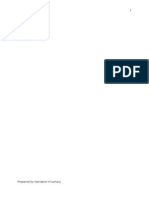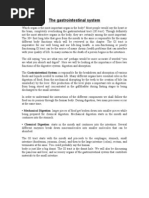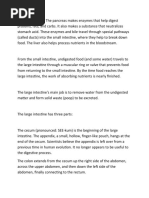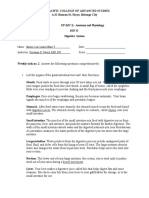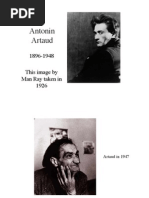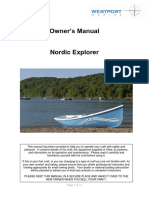Digestion and Absorption
Digestion and Absorption
Uploaded by
DJ DannyCopyright:
Available Formats
Digestion and Absorption
Digestion and Absorption
Uploaded by
DJ DannyOriginal Title
Copyright
Available Formats
Share this document
Did you find this document useful?
Is this content inappropriate?
Copyright:
Available Formats
Digestion and Absorption
Digestion and Absorption
Uploaded by
DJ DannyCopyright:
Available Formats
Digestion and absorption.
Through digestion, macromolecular nutrients are split into their low-molecular building blocks
while absorbing water (hydrolytically). These can then be absorbed by intestinal cells and
transported to the blood and lymph (absorption). The body can only utilize the ingested food
when the substances can reach the cells through the cell membrane. Most of the substances
contained in food consist of relatively large molecules and therefore cannot be absorbed
immediately. Enzymatic cleavage during digestion breaks down the proteins into amino acids,
the fats into glycerol and fatty acids, the carbohydrates into monosaccharides and the nucleic
acids into nucleotides. Water, vitamins and most inorganic ions are absorbed unchanged (Fig.
148.1). The reactions to break the macromolecules require activation energy. For this reason,
they only run at significant speed when digestive enzymes are present (p. 86). In humans, these
digestive enzymes are formed in the digestive glands (e.g. salivary glands, pancreas). Precursors
of certain enzymes are secreted from the gastric mucosa. Eventually, the smaller molecules are
transported to the blood and lymph.
Digestion and absorption in the animal kingdom.
The digestive organs are designed differently in the different animal groups despite having the
same function. Hollow animals and lower worms, i.e. worms without a body cavity, such as liver
fluke or tapeworm, have a blindly closed intestine. In it, the food is broken down by enzymes to
such an extent that it can be taken up by cells of the intestinal wall and finally digested there.
Therefore, phagocytes and gland cells are found in the intestinal wall. In the more advanced
invertebrates and in all vertebrates, the digestive process is completely in the cavity of a special
digestive tract. It is digested outside the cells (extracellular). The cells now only have to produce
the digestive juices and reabsorb the digested food components. A continuous intestinal tube
makes it possible to ingest food before the previously ingested one is completely digested. The
enzymes act on the food flow one after the other. This "assembly line work" considerably
increases the performance of the digestive system. The intestinal tract, which in ringworms still
runs through the body as a simple tube, is more structured in the more advanced animals.
Glandular cells are assembled together. The digestive glands can further specialize and only
supply certain enzymes. A division of labor can also be observed in the area of the intestinal
tract. Digestion breaks down nutrients into smaller molecules (Fig. 148.1) and then from
intestinal cells added.
Digestion and absorption in humans.
The mechanical comminution of food takes place in humans in the mouth. The front section of
the intestinal tract (mouth, stomach) stores and pre-digests. The middle part (small intestine)
is the place of main digestion and absorption. The end section (large intestine, rectum) stops
absorption and forms the feces. Because of its length, the intestine is in loops. Its resorbing
surface is considerably enlarged by folds and protrusions (villi). This applies not only to humans,
but to all vertebrates. In the mouth, the food is prepared for digestion by chewing and
salivating. The daily amount of oral saliva is about 1.5 liters. The mouth saliva is formed in
numerous small glands on the walls of the oral cavity and tongue as well as in three large paired
glands, the parotid, lower jaw and tongue glands. The saliva reacts neutrally. It contains mucus,
the enzyme amylase and salts. The main task of saliva is to moisten the food. Amylase breaks
down part of the starch into maltose; it works optimally in the neutral area. The processed food
slides into the esophagus in portions when swallowed. It is transported to the stomach
entrance by peristaltic waves and finally pushed into the stomach. A peristaltic wave occurs
when the ring muscles contract at one point. This severely constricts the inside of the
esophagus. The contraction wave travels over the esophagus towards the stomach and pushes
the chyme in front of it. Therefore, you can swallow even in the headstand. The stomach is the
widest part of the intestinal tract. It accumulates the food and gradually releases it to the
intestine in small quantities. The gastric mucosa contains innumerable small glands (Fig. 149.1).
These produce mucus, hydrochloric acid and pepsinogen, a precursor of pepsin, in various cells.
The enzyme pepsin in gastric juice is used to break down proteins into peptides. In the
pepsinogen, the active center of the pepsin is covered by a piece of the peptide chain (peptide
sequence). This piece is slowly split off under the influence of hydrochloric acid (Fig. 149.2).
Pepsin that has already been formed is then able to cleave pepsinogens itself. The release of
inactive pepsin prevents it from already working in the cell and destroying it. Two liters of
gastric juice are formed each day. Due to its free hydrochloric acid content (0.2 to 0.5%) it
reacts strongly acidic. Hydrochloric acid kills bacteria in the porridge, it denatures the proteins
it contains and sets the optimal pH environment for pepsin (Fig. 87.1). The self-digestion of the
stomach and intestinal walls by the enzymes is prevented by a mucus layer on the cells. The
mucous membrane on the inside of the intestine is constantly renewed. The rejected cells form
part of the feces. Cross folds enlarge the entire intestinal surface. In the area of the small
intestine, the intestinal surface is also covered with villi (Fig. 150.1b). These are 1 mm long,
cone-shaped protuberances of the mucous membrane. 1 mm² can carry up to 30 small intestine
villi. Each villus contains a lymphatic vessel, blood vessels and nerve and muscle fibers. The villi
enlarge the surface of the small intestine to 4 to 5 m². However, the greatest expansion of the
intestinal surface is caused by millions of microscopic, finger-like protuberances of the mucous
membrane cells. These protuberances are also called microvilli. They form a kind of brush
border that absorbs the nutrients and transports them into the bloodstream (Fig. 150.1). It
gives the entire surface of the small intestine a size of up to 200 m². As soon as acidic chyme
reaches the first section of the small intestine, the duodenum, from the stomach, its mucous
membrane separates the intestinal juice. It has an alkaline reaction and contains various
enzymes:
- Exopeptidases, which break down large protein molecules (polypeptides) by splitting off
amino acids,
- Enterokinase, which activates the protein-splitting pancreatic trypsin, and
- several enzymes that split carbohydrates. The pancreas behind the stomach releases
pancreatic juice and the liver bile into the duodenum.
The pancreas (juice) contains numerous enzymes for fat, protein and carbohydrate digestion
and is secreted by glandular cells (Fig. 150.2). What is striking in these cells is the strong
development of the endoplasmic reticulum covered with ribosomes. Ribosomes are the sites
for the construction of proteins and thus also of enzymes. Cell clusters are scattered into the
glandular tissue of the pancreas, the Langerhans islets. They secrete insulin and glucagon into
the blood, two important hormones for the regulation of blood sugar levels. A permanently
elevated blood sugar level can lead to nerve damage in the arms, legs and organs, to brain
damage, to the development of arteriosclerosis and the resulting diseases, such as a heart
attack. The nutrients and vitamins are absorbed into the blood and lymphatic system through
the cells of the small intestinal mucosa. A large vein, the portal vein, collects the blood that is
loaded with nutrients and directs it to the liver (Fig. 150.1). The liver is the largest gland in the
human body. It is traversed by the finest vascular branches (capillaries) starting from the portal
vein. A second network of the finest capillaries, which originates from the hepatic artery,
supplies the liver cells with oxygen. Bile is constantly formed in the liver. This is collected in the
gallbladder duct and sent to the gallbladder. There it is thickened, stored and pressed into the
intestine as required. The bile acids it contains can break down fat into fine droplets. The
greenish-yellow color of the bile is caused by the bile pigments. They are formed in the liver
cells from the dyed red blood cells and are therefore excretion products. The bile pigments
cause the feces to turn brown and the urine to turn yellow. The liver is involved in a large
number of metabolic processes and therefore produces a lot of heat. It builds the starch-like
reserve carbohydrate glycogen from glucose and stores it. It also builds up fat. With the
intensive protein metabolism of the liver, breakdown products are created which are converted
into urea and uric acid. The liver draws toxins from the blood and breaks them down. The same
applies to aged red blood cells. The liver can therefore be called the “chemical center” of the
body. The small intestine opens out laterally into the 5 to 8 cm wide colon. At the transition
from the small intestine to the large intestine, the appendix joins the appendix. The appendix is
part of the body's defense system. It is at particular risk of infection (“appendicitis”). The glands
of the large intestinal mucosa only deliver mucus, but no enzymes. The large intestine is
populated by numerous bacteria (e.g. Escherichia coli, p. 197), which among other things
produce vitamins. These vitamins are absorbed into the blood vessel system via the intestinal
wall. Unilateral diet and medicines, such as antibiotics, can interfere with the composition of
this intestinal flora. Water is extracted from the thin intestinal contents in the large intestine so
that the body recovers a large part of the fluid. If too little water is withdrawn, diarrhea occurs.
The contents of the intestine finally end up in the rectum as feces. The droppings consist of
indigestible and undigested residues of the food. It also contains rejected intestinal cells and
intestinal bacteria, which together can make up to a third of the amount of feces. The rectum is
closed off by the strong sphincter muscles of the anus and is usually empty. The rectum has two
sphincters. Due to the increased filling in the rectum, receptors are stimulated. These cause a
reflex relaxation of the inner sphincter. At the same time, a reflex tension of the outer sphincter
is triggered. The increased pressure in the rectum triggers an urge to stool.
You might also like
- IGH0502 IDocument1 pageIGH0502 IVivek Rajagopal0% (1)
- Fourteen Folk Dances For Tin Whistle or Recorder and Guitar (Peter Billam)Document12 pagesFourteen Folk Dances For Tin Whistle or Recorder and Guitar (Peter Billam)Nilpima100% (4)
- Phil Heath Workout RoutineDocument2 pagesPhil Heath Workout RoutineYamir VelazcoNo ratings yet
- Overview of The Digestive SystemDocument9 pagesOverview of The Digestive SystemMehmet SaylıkNo ratings yet
- The Digestive System A Level NotesDocument7 pagesThe Digestive System A Level Noteselendria100% (1)
- Digestive System A&p BookletDocument11 pagesDigestive System A&p Bookletnurse1990No ratings yet
- Anatomy and Physiology of Human Digestive System: The Mouth and PharynxDocument9 pagesAnatomy and Physiology of Human Digestive System: The Mouth and Pharynxitachi278No ratings yet
- Running Head: 1: The Process of Human DigestionDocument5 pagesRunning Head: 1: The Process of Human Digestiongmelendez2No ratings yet
- Digestion and Absorption of Food in ManDocument3 pagesDigestion and Absorption of Food in Mancd78x8xbsxNo ratings yet
- Modular Handout and Worksheet For April 19-21-2023Document5 pagesModular Handout and Worksheet For April 19-21-2023ccam88743No ratings yet
- Digestive SystemDocument12 pagesDigestive Systemapi-269652707No ratings yet
- Digestive System ReadingDocument6 pagesDigestive System ReadingcholzNo ratings yet
- Pancreas: FunctionDocument3 pagesPancreas: FunctionitsankurzNo ratings yet
- Digestive System HandoutDocument7 pagesDigestive System Handouttheodore_estradaNo ratings yet
- Organ Tubuh Manusia EnglishDocument6 pagesOrgan Tubuh Manusia EnglishL-Viva'An Ri-l SpqNo ratings yet
- LABSTER Absorption in The Small and Large IntestinesDocument15 pagesLABSTER Absorption in The Small and Large IntestinesAnonymous rYJJiYhFCNo ratings yet
- Anatomy AssignmentDocument9 pagesAnatomy AssignmentCharles RajNo ratings yet
- Food and Nutrient DigestionDocument34 pagesFood and Nutrient DigestionvinodhknatrajanNo ratings yet
- Master HerbalistDocument91 pagesMaster HerbalistVázsonyi Júlia67% (3)
- The Digestive System (Anatomy)Document11 pagesThe Digestive System (Anatomy)Pia Sempron100% (1)
- Digestive System Alimentary Tract of The Digestive System MouthDocument5 pagesDigestive System Alimentary Tract of The Digestive System MouthJoNo ratings yet
- AnaphyDocument5 pagesAnaphyAnne BrazilNo ratings yet
- How Is Food DigestedDocument12 pagesHow Is Food DigestedNationalKidNo ratings yet
- Anatomy and Physiology of Gastrointestinal TractDocument23 pagesAnatomy and Physiology of Gastrointestinal TractJasmin Jacob100% (4)
- G7 UNIT - 2 NOTESDocument9 pagesG7 UNIT - 2 NOTESalyx.axhhNo ratings yet
- Digestive System Grade 10-11Document7 pagesDigestive System Grade 10-11Nandana Nayana KumaraNo ratings yet
- BIO103 Lec-17.46 ArIm Digestive System 220424Document27 pagesBIO103 Lec-17.46 ArIm Digestive System 220424bilashqipNo ratings yet
- Reviewer ElsDocument8 pagesReviewer ElsAnsel Francis RapsingNo ratings yet
- Human Digestive SystemDocument11 pagesHuman Digestive SystemSyeda NafeezaNo ratings yet
- Human Digestive SystemDocument11 pagesHuman Digestive SystemSyeda NafeezaNo ratings yet
- Anatomy and Physiology of The Digestive SystemDocument5 pagesAnatomy and Physiology of The Digestive SystemJesrel DelotaNo ratings yet
- SNS AssignmentDocument21 pagesSNS AssignmentthabolasebjadiNo ratings yet
- Chapter 6 - DigestionDocument17 pagesChapter 6 - DigestionTrisha100% (1)
- BG3-3-The Digestive and Respiratory SystemsDocument36 pagesBG3-3-The Digestive and Respiratory Systemsapa@No ratings yet
- Sci Reviewer 2Document7 pagesSci Reviewer 2Aiko AbyzouNo ratings yet
- The Digestive SystemDocument23 pagesThe Digestive SystemJenderal Yohanes100% (1)
- Nutrition in Human BeingsDocument19 pagesNutrition in Human Beingsrushathk99No ratings yet
- The Small IntestineDocument13 pagesThe Small IntestineChristina BinoboNo ratings yet
- HAP-II RECORDDocument15 pagesHAP-II RECORDgavanderohit45No ratings yet
- The Digestive System Study GuideDocument6 pagesThe Digestive System Study GuideMohamed ArafaNo ratings yet
- Ulcerative Colitis FinalDocument13 pagesUlcerative Colitis FinalAngelique100% (1)
- Small IntestineDocument9 pagesSmall Intestinegetsukhdev1No ratings yet
- MUCLecture_2022_52142525Document10 pagesMUCLecture_2022_52142525zryanm88mustafaNo ratings yet
- Anatomy and PhysiologyDocument13 pagesAnatomy and Physiologydaculareyndel04No ratings yet
- Biology 11 - June Final Exam NotesDocument15 pagesBiology 11 - June Final Exam NotesagbavaNo ratings yet
- DisgestionDocument1 pageDisgestionandressookdeo29No ratings yet
- Overview of The Digestive SystemDocument24 pagesOverview of The Digestive SystemTarun Kumar SinghNo ratings yet
- Peptic Ulcer FinalDocument19 pagesPeptic Ulcer FinalPrince DiuNo ratings yet
- The Anatomy of The StomachDocument33 pagesThe Anatomy of The StomachVictor OmoloNo ratings yet
- VIII Biology Digestion Handout 2Document9 pagesVIII Biology Digestion Handout 2Sangita PervinNo ratings yet
- PointersDocument5 pagesPointersKean AtonNo ratings yet
- Wa0004.Document16 pagesWa0004.odebiyidavid123No ratings yet
- Digestive System Label MeDocument13 pagesDigestive System Label MeMuhammad AdibNo ratings yet
- Minute Friut CoolerDocument6 pagesMinute Friut CoolerCamaya RumbleNo ratings yet
- Human Digestive SystemDocument29 pagesHuman Digestive SystemRagini Dubey100% (1)
- Name: Santos, Lore Anne Mhae T. Date: - Instructor: Giovanni D. David, Edd, RN ScoreDocument4 pagesName: Santos, Lore Anne Mhae T. Date: - Instructor: Giovanni D. David, Edd, RN ScoreLore Anne Mhae SantosNo ratings yet
- Digestive SystemDocument2 pagesDigestive SystemIlaria MassafraNo ratings yet
- Anatomy and PhysiologyDocument3 pagesAnatomy and PhysiologyKayze UbaldoNo ratings yet
- c11 Special Animal NutritionDocument14 pagesc11 Special Animal NutritionAlexandra AlexandraNo ratings yet
- Nutrition in Humans: By: Khizar Hayat & Ade Bhai 10-ADocument40 pagesNutrition in Humans: By: Khizar Hayat & Ade Bhai 10-AWaqas TahirNo ratings yet
- Digestive SystemDocument11 pagesDigestive SystemGURNOOR KAURNo ratings yet
- Leaky Gut Syndrome for Beginners - The Self-Help Book - How to Correctly Interpret the Symptoms of a Leaky Gut, Identify the Causes and Heal Your Gut Step by StepFrom EverandLeaky Gut Syndrome for Beginners - The Self-Help Book - How to Correctly Interpret the Symptoms of a Leaky Gut, Identify the Causes and Heal Your Gut Step by StepNo ratings yet
- The Two Contrasting Capitals of Classical EuropeDocument2 pagesThe Two Contrasting Capitals of Classical EuropeDJ DannyNo ratings yet
- ACFrOgDtHi9iLBupOwo3cV0qaIRE4ITLB9X 7AbxQoqGzEfjMCo8JMMbcYJCcWfrMg9yuCwdhi0yXpRWrFVAzr46IF9g wJfmPp7zV 9UmLKGcasR9Nu7a4ZXqMDBEVFFEVjLCIVVctMVKnStODkDocument46 pagesACFrOgDtHi9iLBupOwo3cV0qaIRE4ITLB9X 7AbxQoqGzEfjMCo8JMMbcYJCcWfrMg9yuCwdhi0yXpRWrFVAzr46IF9g wJfmPp7zV 9UmLKGcasR9Nu7a4ZXqMDBEVFFEVjLCIVVctMVKnStODkDJ DannyNo ratings yet
- I Was On Top of The World!: Daniel - Sirghii025Document1 pageI Was On Top of The World!: Daniel - Sirghii025DJ DannyNo ratings yet
- From: Daniel Sîrghii To: John Mcgregor Subject: Your Email To Ms BeurerDocument1 pageFrom: Daniel Sîrghii To: John Mcgregor Subject: Your Email To Ms BeurerDJ DannyNo ratings yet
- Formal E-Mail, P. 106, Daniel SirghiiDocument1 pageFormal E-Mail, P. 106, Daniel SirghiiDJ DannyNo ratings yet
- Quantity Surveying Sheet - PDFDocument46 pagesQuantity Surveying Sheet - PDFjayvincentrubioNo ratings yet
- SITHCCC030 Service Planning Template v1.1Document4 pagesSITHCCC030 Service Planning Template v1.1Binod Maharjan100% (2)
- SRS Pattasu Kadai AllDocument2 pagesSRS Pattasu Kadai Allmanojkumar070902No ratings yet
- SPELLING BEE Year 8 2023 List of Words-1Document2 pagesSPELLING BEE Year 8 2023 List of Words-1rtgpbjgvj9No ratings yet
- Antonin Artaud: 1896-1948 This Image by Man Ray Taken in 1926Document38 pagesAntonin Artaud: 1896-1948 This Image by Man Ray Taken in 1926ed_scheer9252No ratings yet
- Amplificador XM-ZR602 PDFDocument2 pagesAmplificador XM-ZR602 PDFenriquerojoperez_539No ratings yet
- ASL - VFTT 10Document16 pagesASL - VFTT 10deitti333No ratings yet
- TCX 525Document4 pagesTCX 525dionisio emilio reyes jimenezNo ratings yet
- Ejercicio 9Document7 pagesEjercicio 9Pérez De Aquino Jesus AmadoNo ratings yet
- American FugitiveDocument34 pagesAmerican FugitiveYOND drNo ratings yet
- Homelite HL-EH-LR Rebuild Kit Tech Bulletin Rev ADocument8 pagesHomelite HL-EH-LR Rebuild Kit Tech Bulletin Rev AAMWATSON6754No ratings yet
- 70-Masquerade Is OverDocument4 pages70-Masquerade Is Overizdr1No ratings yet
- Nordic Explorer Owners ManualDocument13 pagesNordic Explorer Owners ManualPepe AlcantaraNo ratings yet
- U5-6 S1-W2 Dribbling-Change of DirectionDocument6 pagesU5-6 S1-W2 Dribbling-Change of Directionjesek ionut danNo ratings yet
- QFK Cycle 3 RecipesDocument14 pagesQFK Cycle 3 RecipesYash AdityaNo ratings yet
- CWNF MidtermDocument2 pagesCWNF MidtermJuainy SA100% (1)
- CSS FontsDocument20 pagesCSS FontsKawaii GlamourNo ratings yet
- Competitive Comparison Chart Honeywell IRIS 700 Vs LG Summary Feb 10-2012Document2 pagesCompetitive Comparison Chart Honeywell IRIS 700 Vs LG Summary Feb 10-2012Jorge VieyraNo ratings yet
- MT-2 Lab Manual Rajalaksmi PDFDocument11 pagesMT-2 Lab Manual Rajalaksmi PDFlenojerin3486No ratings yet
- Audiovox Avp7280 - 7200Document52 pagesAudiovox Avp7280 - 7200Justin WilliamsNo ratings yet
- TeardropsDocument2 pagesTeardropsRegine van Zeveren100% (1)
- Volley Beach: by Jessica, Rana, Mehwish, Rachel, Philip, Rex and GlennDocument22 pagesVolley Beach: by Jessica, Rana, Mehwish, Rachel, Philip, Rex and GlennMahek MunawarNo ratings yet
- Paket 5Document8 pagesPaket 5Indah Dwi CahayanyNo ratings yet
- Floor Box Catalogue 2021Document9 pagesFloor Box Catalogue 2021TomNo ratings yet
- Don't Cry, Joni (Conway Twitty & Joni Lee) : LL GrowDocument2 pagesDon't Cry, Joni (Conway Twitty & Joni Lee) : LL Growalic_231874137No ratings yet
- A Sudden Silence Eve Bunting May 14 Noah SnauwaertDocument4 pagesA Sudden Silence Eve Bunting May 14 Noah SnauwaertNoah SnauwaertNo ratings yet
- Principles of Marketing: Lesson 1 Marketing Is The Creation and Communication of Value To CustomersDocument8 pagesPrinciples of Marketing: Lesson 1 Marketing Is The Creation and Communication of Value To CustomersKimberly Ann NoceteNo ratings yet

























